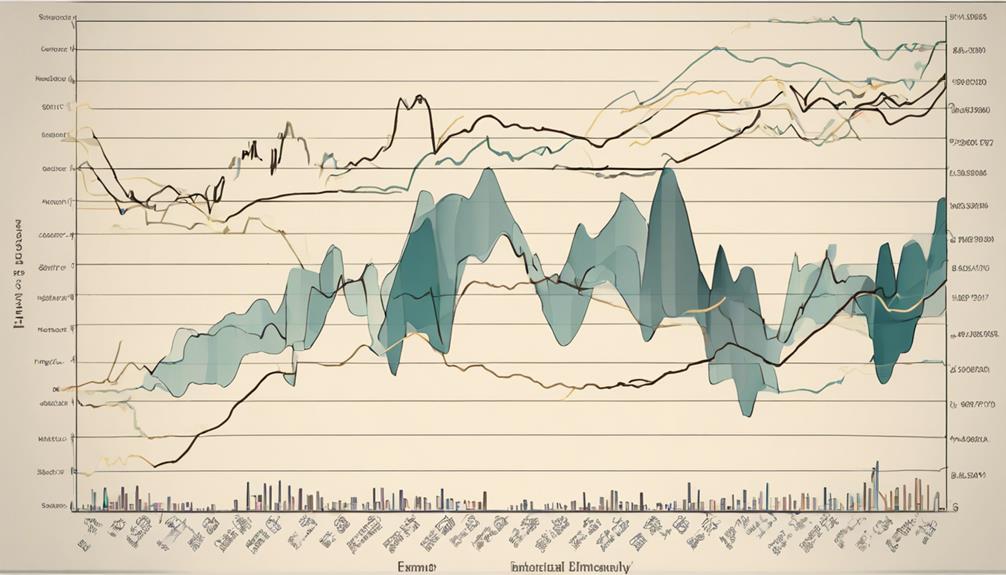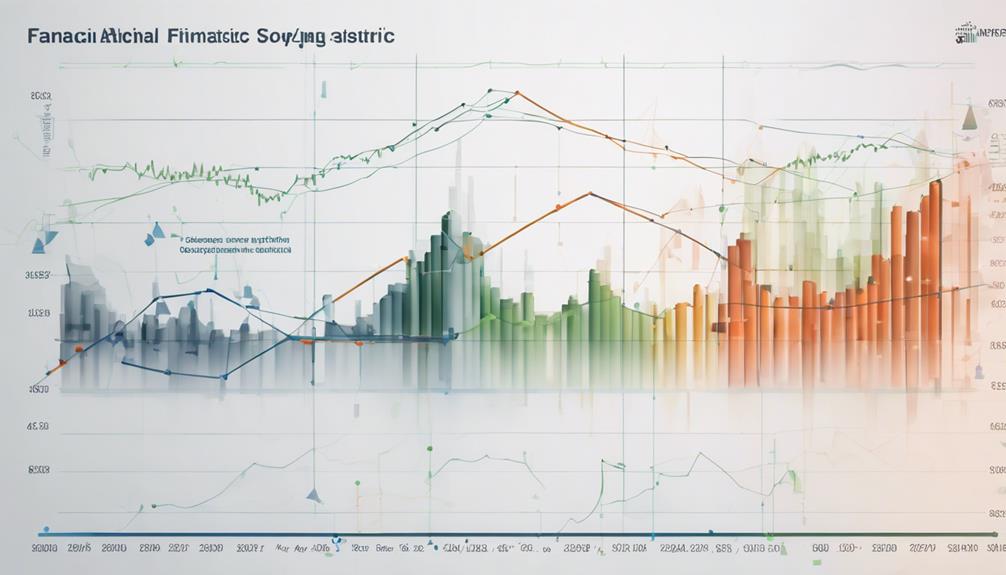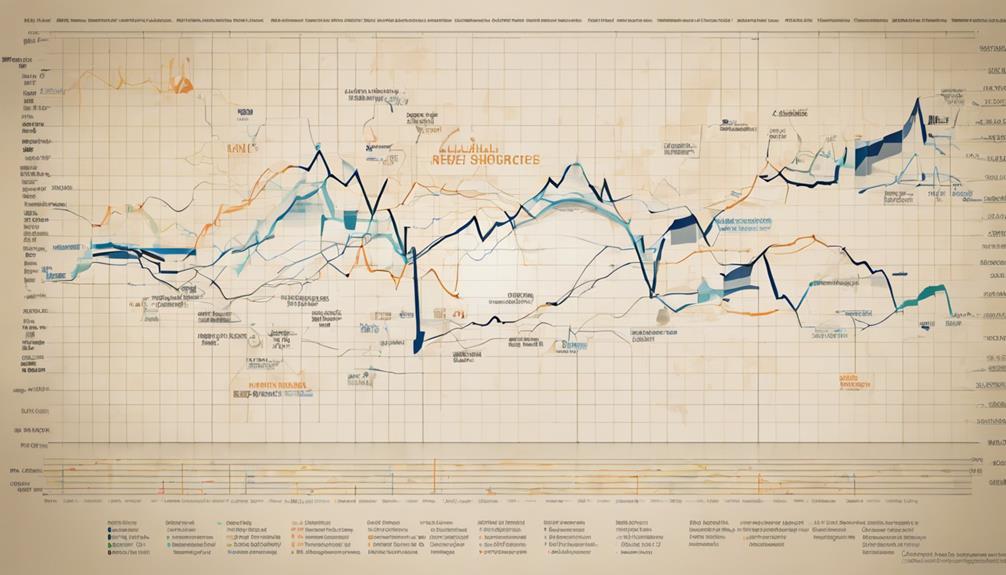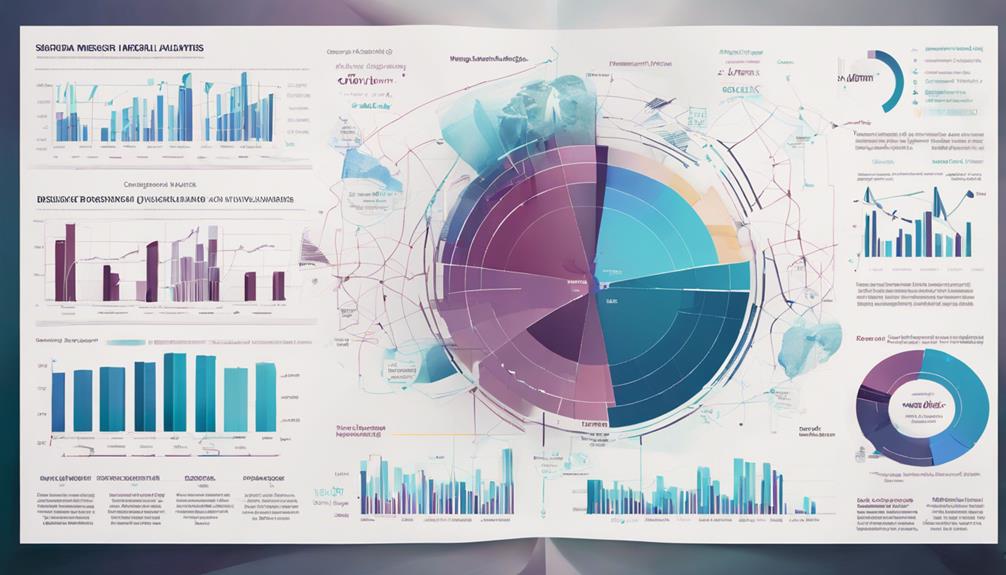Financial Analysis of Forward Mergers

Understanding the significance of a comprehensive financial analysis is crucial when contemplating a forward merger, where the target company is integrated into the acquiring entity. The process involves assessing potential synergies, creating detailed financial projections, and comparing the target's adjusted historical data with industry peers. It is essential to carefully consider integration costs and the challenges of change to ensure the merger's sustained profitability.
Through this meticulous analysis, well-informed decisions can be made to deliver value to all stakeholders. Let's delve into strategies for effectively integrating forward mergers.
Forward mergers involve the merging of two companies where the target company becomes part of the acquiring entity. This type of merger can lead to operational efficiencies, increased market share, and enhanced competitiveness in the industry. By analyzing potential synergies between the two companies, businesses can identify opportunities to streamline operations, reduce costs, and maximize overall performance.
Developing detailed financial projections is another critical aspect of the financial analysis process in forward mergers. By forecasting the combined financial performance of the merged entity, companies can assess the potential impact on revenue, expenses, and profitability. This helps in setting realistic expectations and identifying areas for growth and improvement post-merger.
Benchmarking the target company's adjusted historical data against industry peers is also a key step in financial analysis. This allows companies to evaluate the target's financial performance in comparison to similar companies in the industry. By identifying strengths, weaknesses, and areas for improvement, businesses can make informed decisions about the merger and integration process.
In conclusion, a thorough financial analysis is essential for the success of forward mergers. By evaluating synergies, developing financial projections, and benchmarking historical data, companies can make informed decisions that drive long-term profitability and create value for all stakeholders involved.
Key Takeaways
When analyzing a forward merger, it is crucial to conduct a thorough financial due diligence of the target company to understand its financial position and potential risks. This involves examining the target's financial statements, cash flow, debt levels, and other key financial metrics to assess its overall health.
In addition to financial due diligence, it is essential to evaluate the operational and financial synergies that could result from the merger. By identifying areas where cost savings can be achieved or revenue can be enhanced through the combination of both companies, you can better understand the potential benefits of the merger.
Developing comprehensive financial projections that take into account the impact of the merger is also important. This includes factoring in integration expenses, potential synergies, and post-merger performance to create a realistic outlook for the merged entity.
Benchmarking the financial performance of the merged entity against industry standards is crucial to ensure that the merger creates long-term value. By comparing key financial metrics such as profitability, liquidity, and efficiency to industry peers, you can assess the success of the merger and identify areas for improvement.
Engaging M&A professionals who are experts in financial modeling, valuation, and negotiation strategies can provide valuable guidance throughout the merger process. Their expertise can help you make informed decisions and navigate the complexities of merging two companies successfully.
Meaning and Overview of Forward Mergers
A forward merger involves the target company merging directly into the acquiring company, essentially dissolving as a separate entity. In this scenario, the buyer company takes on all the assets and liabilities of the target, streamlining the integration process. However, this approach also exposes the acquiring company to potential risks related to the target's obligations and legal concerns.
Forward mergers are a common strategy in corporate acquisitions because they facilitate the blending of two organizations. Nevertheless, thorough due diligence is crucial to ensure a smooth transition. A variation of the forward merger is the Forward Triangular Merger, where a subsidiary of the buyer company is the entity that merges with the target.
Analyzing the financial consequences and potential risks of forward mergers is vital for making well-informed decisions in strategic business deals. By grasping the essence and overview of this merger type, organizations can navigate complexities and enhance the outcomes of their growth strategies.
Key Steps in Forward Merger Analysis
When evaluating the financial viability of a forward merger, it's crucial to analyze the potential synergies between the merging companies. By identifying how their combined strengths and resources can create value that surpasses their individual capabilities, we can determine the strategic advantages of the merger.
To assess the long-term impact on profitability, cash flow, and overall financial health, detailed financial projections must be developed. These projections will provide insights into the potential growth opportunities, cost savings, and revenue enhancements that can result from the merger.
Conducting a thorough analysis is essential to ensure the success of the merger and avoid overpayment for the acquired business. By carefully evaluating the synergies and financial projections, we can make informed decisions that maximize the benefits of the forward merger and create value for all stakeholders involved.
Synergy Evaluation
When assessing potential synergies in a forward merger, it's crucial to evaluate how combining the operations of the merging entities can create value. This evaluation involves looking at cost savings, revenue opportunities, and operational efficiencies that could result from the merger.
Areas such as shared services, supply chain improvements, and cross-selling possibilities are thoroughly examined to identify potential synergies.
Additionally, it's important to consider the cultural fit and technology integration between the merging companies. A harmonious alignment in these areas can unlock significant synergies, while any misalignment could have negative consequences.
Market synergies are also explored to determine how the combined entity can better serve customers and enhance its competitive position.
Quantifying these synergies plays a vital role in determining the overall value of the merger. By conducting a comprehensive analysis, we can gain a clear understanding of the potential for value creation, which in turn informs strategic decision-making and shapes post-merger integration strategies.
Therefore, synergy evaluation is a critical aspect of conducting a thorough analysis of a forward merger.
Financial Projections
When assessing the potential value of a forward merger, it's crucial to create forward-looking financial projections. An essential first step is to analyze the historical financial trends of the merging entities and carefully adjust their financial statements to eliminate any unnecessary expenses or distortions that could misrepresent their true financial status.
To begin, we benchmark the target company's performance against industry data to pinpoint both opportunities and challenges.
Next, we develop detailed projections that take into account expected changes in the business environment. It's important to rigorously assess the realism and achievability of these projections through sensitivity analysis and stress testing.
Throughout this process, we must maintain a sharp focus on data quality, expense adjustments, and potential synergies, all with the goal of avoiding overpayment.
Thorough scrutiny by experienced professionals is essential to ensure the accuracy and dependability of the financial analysis, guiding well-informed decision-making in the context of a forward merger.
Importance of Historical Financial Statement Review

When analyzing a company's financial statements, it's crucial to delve into the historical data to uncover valuable insights. By scrutinizing past trends, we can detect any irregularities or inconsistencies that may impact our decision-making regarding the company's financial well-being and future performance.
Furthermore, comparing the financial metrics to industry benchmarks will provide us with a clearer picture of where the company stands relative to its competitors.
In the realm of mergers and acquisitions, one common strategy is a forward merger. In this type of merger, one company merges with and absorbs another company, leading to the consolidation of the two entities. This approach allows the acquiring company to expand its market presence, diversify its product offerings, or achieve other strategic objectives.
Forward mergers can be beneficial for companies looking to achieve rapid growth or enter new markets efficiently. Understanding the dynamics of forward mergers and the financial implications involved is essential for investors and stakeholders.
Examine Financial Statements
Thoroughly examining a company's historical financial statements is a crucial initial step in conducting a comprehensive financial analysis for a forward merger. This critical process helps uncover insights that inform merger and acquisition strategies.
Analyzing revenue, expense, and profitability trends over time reveals the company's financial health and stability. This historical context is invaluable when projecting future performance.
Benchmarking the company's financials against industry standards provides vital perspective on its relative standing, allowing for a better assessment of its competitive position. Uncovering patterns in the data can shed light on the underlying drivers of the business, which are key to identifying synergies and integration opportunities.
Assess Historical Trends
Studying a company's historical financial records is crucial for gauging its performance trajectory and evaluating potential forward merger opportunities. By examining the company's previous revenues, expenses, and profits, we can pinpoint trends that illuminate its financial stability, growth patterns, and possible risks. This historical data acts as a valuable reference point, enabling us to measure the company's performance against industry benchmarks and peer comparisons.
This thorough analysis provides us with essential insights that guide our decision-making process. For example, consistent revenue growth or decreasing expenses over time may indicate a well-managed company with a solid competitive position. On the other hand, spotting worrisome trends like declining profit margins or increasing debt levels can raise red flags that necessitate further exploration.
Ultimately, comprehending a company's historical financial performance serves as a fundamental aspect of sound financial analysis and strategic planning. By diligently scrutinizing these financial statements, we position ourselves to make well-informed decisions and uncover opportunities that could lead to successful forward mergers.
Adjusting Financial Data for Non-Essential Expenses
When assessing companies for potential mergers, it's common practice to adjust financial data by excluding non-essential expenses. This helps in gaining a clearer picture of a company's fundamental operational performance and profitability, which is crucial for making informed decisions regarding mergers.
By recalculating historical financial statements and eliminating non-core expenses, we can reveal the true underlying profitability of the company without the influence of irrelevant costs. This ensures that our financial analyses and projections are based on the most pertinent and precise information, laying a strong groundwork for evaluating merger prospects.
Analyzing the effects of these expense modifications on future profitability and operational efficiency is essential to understanding the genuine potential of a merger. This evaluation aids in making well-founded decisions and assessing the feasibility of the merger opportunity.
Through this meticulous financial analysis strategy, we can adeptly navigate the intricate merger landscape, pinpointing the most promising avenues for growth and success.
Benchmarking Adjusted Financial Data to Industry

Adjusting the financial data to exclude non-essential expenses allows us to compare the recasted figures with industry standards, giving us a clearer picture of the company's competitiveness and performance. By analyzing the adjusted financials in relation to relevant industry benchmarks, we can uncover valuable insights that will guide our evaluation process.
Industry benchmarks serve as a crucial point of reference, enabling us to evaluate how the company's key metrics compare to those of its peers. This analysis can highlight the company's strengths and weaknesses relative to industry norms, helping us make well-informed strategic decisions.
Are the company's profit margins, liquidity ratios, and growth rates in line with or surpassing those of its competitors? Identifying these insights can pinpoint areas for improvement and optimization, ultimately strengthening the company's long-term sustainability.
Benchmarking the adjusted financial data is a vital step in our comprehensive evaluation, providing us with the data-driven insights necessary to navigate the complexities of this forward merger with confidence.
Constructing Forward-Looking Financial Projections
Crafting forward-looking financial projections involves a comprehensive examination of historical data to accurately forecast the company's future performance. By meticulously analyzing expenses, revenues, and other financial metrics, we make necessary adjustments to account for anticipated changes. This process allows us to develop a realistic and reliable roadmap for decision-making, grounded in a thorough understanding of the company's financial landscape.
Our projections are built upon a solid foundation of past financial performance, enabling us to make informed predictions about future profitability and growth potential. By carefully considering these factors, we can guide our decision-making process with confidence, ensuring that our strategies align with the company's long-term goals and objectives.
Attention to detail and a commitment to accuracy are central to our rigorous financial modeling approach. By comparing our projections to industry benchmarks, we can validate their accuracy and reasonableness, providing further assurance that our forecasts are realistic and reliable.
This meticulous approach allows us to anticipate challenges and opportunities, enabling us to make well-informed decisions that drive the company's success.
Evaluating Expense Adjustments and Future Profitability

When assessing the expense adjustments and future profitability projections of a merger, it's essential to ensure the accuracy and feasibility of these financial aspects. This evaluation is crucial for understanding how the merged entity's financial performance may unfold post-merger.
Expense adjustments play a significant role in shaping the financial landscape of the merged entity. By identifying areas where costs can be minimized, quantifying the financial impact of these adjustments, and assessing the operational feasibility of implementing these changes, we can gauge the potential for cost savings and sustainable cost structures. It's important to validate the proposed changes, ensuring they aren't overly optimistic and don't negatively impact the target company's operations.
To validate the expense adjustments and profitability projections, it's crucial to scrutinize the data sources and assumptions behind these figures. By aligning expense adjustments with realistic and sustainable cost structures, we can confirm that the projected reductions are achievable without compromising operational performance. This thorough evaluation helps in avoiding any hindrances to the smooth functioning of the merged entity.
Assessing Potential Merger Synergies
Having analyzed the expense adjustments and profitability projections, we can now focus on evaluating the potential merger synergies that could drive improved financial performance for the combined entity. It's crucial to identify and quantify these synergies to estimate the financial impact of the merger and justify the transaction.
There are several areas where synergies can be realized in a forward merger:
- Operational improvements and economies of scale can lead to significant cost savings.
- Expanded market reach and enhanced product offerings have the potential to drive revenue growth.
- Cross-selling opportunities and shared technology resources can improve overall efficiency.
Effective post-merger integration planning will be essential to capture and maximize these synergies. By prioritizing synergy identification and realization, we can build a strong financial case for the merger that showcases the value it will generate for the organizations involved.
With a comprehensive understanding of the potential synergies, we're well-equipped to make an informed decision on the strategic benefits of this forward merger.
Ensuring Data Quality and Projection Realism

Ensuring the quality and reliability of financial data is crucial when assessing the viability of a forward merger. It's essential to validate this information in accordance with Generally Accepted Accounting Principles (GAAP) to ensure compliance and transparency in our projections.
Examining the target company's corporate income tax returns can offer valuable insights into their financial well-being and reporting standards. Furthermore, assessing the reliability of interim financial results provides a snapshot of the company's performance over a specific period.
To further authenticate the financial data, we'll seek validation through an external audit or review by a Certified Public Accountant (CPA). This essential step guarantees the accuracy and dependability of the data we utilize for our projections.
Considering Operational Integration Costs
When considering forward mergers, it's crucial to factor in the operational integration costs. These expenses encompass various elements such as restructuring, integrating technologies, providing employee training, and aligning systems.
Having a well-planned budget and effectively managing these costs is essential for realizing the intended synergies and ensuring the success of the merger.
Evaluating Integration Expenditures
Evaluating integration expenses in forward mergers is crucial as these costs can significantly impact the financial health and success of the newly combined entity. It's essential to carefully analyze the scope and implications of these expenditures to ensure a seamless transition and maximize synergies post-merger.
When assessing integration expenses, it's important to consider various factors such as the costs associated with restructuring, retraining employees, and upgrading technology to harmonize business operations, systems, and processes. Legal fees related to regulatory compliance and contract negotiations are also significant components to take into account.
Additionally, the potential disruptions or productivity losses during the integration phase can have a direct impact on the financial performance of the merged organization.
Properly planning and budgeting for integration costs can help mitigate financial risks and uncertainties, allowing the merged company to concentrate on realizing the strategic advantages of the merger. By comprehensively understanding the full extent of integration expenditures, informed decisions can be made to drive long-term success and value creation.
Calculating Operational Synergies
Now, let's delve into calculating the operational synergies that can be achieved through the merger, taking into account the associated integration costs. Operational synergies play a crucial role in enhancing value creation in forward mergers by enabling the combined entity to streamline its operations and improve overall efficiency.
To measure these synergies accurately, we need to estimate the potential cost savings and revenue enhancements that will arise from integrating the business functions of the merging companies. This thorough analysis demands a comprehensive understanding of the target company's current processes, systems, and workforce, along with the possibilities for optimization and alignment.
It's equally important to evaluate the expenses related to operational integration, such as aligning technologies, standardizing procedures, and managing workforce transitions. By finding the right equilibrium between realizing synergies and addressing integration hurdles, we can create precise financial forecasts that increase the likelihood of a successful merger outcome.
Mitigating Transitional Challenges
When considering how to overcome challenges during a forward merger, accurately estimating the operational integration costs is crucial. Efficiently managing these expenses can result in significant synergies and cost savings, ultimately enhancing the overall performance of the combined entity.
Key operational integration costs to factor in include:
- Technology integration
- Employee training
- Operational restructuring
Planning and executing integration strategies carefully are essential to minimize disruptions and maximize the benefits after the merger.
It's important to conduct a detailed analysis of these costs to make accurate financial projections and ensure successful merger outcomes.
Making Informed Decisions to Prevent Unfavorable Outcomes

A thorough financial analysis plays a crucial role in making well-informed decisions and avoiding unfavorable outcomes in forward mergers. Understanding the financial health of the target company is key to making strategic choices. It's essential to assess compatibility, potential synergies, and industry dynamics for a successful integration.
By examining the balance sheet, debt levels, and profitability, we can effectively manage risks and leverage opportunities.
To prevent negative consequences, it's important to consider the financial implications, time commitments, and integration obstacles. Engaging in a merger without a deep understanding of the target's financial position can be risky. On the other hand, conducting a comprehensive analysis enables us to make confident decisions that enhance value and minimize disruptions.
As forward-thinking leaders, we've a duty to thoroughly evaluate potential mergers for the benefit of our stakeholders. Through meticulous financial assessment, we can navigate the complexities of forward mergers and secure positive outcomes that drive our organizations forward.
Benefits of Thorough Financial Analysis in Mergers
Conducting a thorough financial analysis is crucial in mergers, as it allows us to identify potential risks and seize opportunities for creating value. By diving deep into the financial data of the target company, we can accurately determine its true worth and avoid paying more than necessary, ensuring a positive outcome for our shareholders.
Through meticulous due diligence, we can scrutinize the financials of the target company, uncovering any hidden liabilities or assets that may be overvalued, which could impact the overall deal. This scrutiny is essential in making informed decisions and protecting our interests.
Analyzing the operational and financial synergies between the target company and our own organization helps us pinpoint areas where we can improve efficiency and cut costs, leading to additional value creation. Seeking advice from experienced professionals in mergers and acquisitions further enhances our evaluation process, drawing on their expertise to navigate complexities and minimize risks.
In essence, a detailed financial analysis empowers us to make well-informed decisions, safeguard our interests, and position the merged entity for long-term success.
Strategies for Successful Forward Merger Integration

When engaging in a forward merger, it's crucial to thoroughly evaluate the financial health and operational compatibility of the target company with our own business. Identifying potential synergies and analyzing key financial metrics such as EBITDA, working capital, and debt levels are vital for a seamless integration process.
EBITDA, which signifies the combined profitability and cash flow potential, plays a significant role in assessing the financial strength of the merged entities. It provides insights into the overall financial performance and can guide decision-making during the integration phase.
Working capital evaluation is essential as it helps in understanding the target company's ability to sustain day-to-day operations post-merger. By analyzing working capital levels, we can anticipate any potential liquidity challenges and plan accordingly to ensure operational continuity.
Debt levels of both companies must be carefully examined to gauge the impact on the balance sheet and determine the financing requirements for the merged entity. Understanding the debt structure and obligations can help in formulating strategies to manage and optimize the overall debt levels post-merger.
Industry-specific adjustments are crucial as different sectors may have unique factors that can influence the integration process. Considering these sector-specific dynamics enables us to tailor our integration strategies to address any industry-related challenges effectively.
Developing contingency plans is essential to mitigate integration risks and uncertainties that may arise during the merger process. By creating alternative strategies and backup options, we can adapt to unforeseen circumstances and ensure a smoother integration experience.
Frequently Asked Questions
What Is the Financial Analysis of a Merger?
When assessing a forward merger, we analyze the target company's financial status, performance, and future projections. Key factors we consider include EBITDA, working capital, debt levels, and overall profitability. By thoroughly evaluating these metrics, we aim to understand the potential impact of the merger on our own financials and operations.
Furthermore, we carefully examine funding options and integration risks associated with the merger. This comprehensive analysis helps us ensure a successful acquisition and seamless integration of the target company into our business operations. By taking into account these various financial aspects, we can make informed decisions and strategically plan for the future growth and success of our organization.
How Do You Financially Evaluate an Acquisition Merger?
When evaluating an acquisition merger, it's essential to consider the type of merger taking place. In the case of a forward merger, one company merges with and absorbs another company. This type of merger can help the acquiring company expand its market share, diversify its product offerings, and reduce competition.
To financially evaluate a forward merger, one key step is to analyze the target company's historical financial performance. This involves reviewing its income statements, balance sheets, and cash flow statements to understand its revenue, expenses, assets, and liabilities over time. By looking at past financial data, we can assess the target's financial health and potential for future growth.
Another important factor to consider in the financial evaluation of a merger is the target company's debt-equity ratio. This ratio helps us understand how much of the target's funding comes from debt versus equity. A high debt-equity ratio may indicate financial risk, while a low ratio may suggest financial stability. By examining this ratio, we can gauge the target's financial leverage and assess its ability to meet its financial obligations post-merger.
In addition to analyzing historical financials and debt-equity ratios, it's crucial to develop projections that take into account potential synergies between the two companies. Synergies can arise from cost savings, revenue enhancements, or other benefits that result from the merger. By forecasting these synergies, we can estimate the potential financial impact of the merger and ensure that it creates value for both companies involved.
What Is the Balance Sheet Analysis for M&A?
Get ready to uncover the secrets of forward mergers with our in-depth balance sheet analysis for M&A! We'll carefully evaluate the target company's liquidity, identify valuable assets, and develop a winning financial strategy that will set you apart from the competition. Our approach is based on solid research and proven methodologies, ensuring that you make informed decisions and drive success in your M&A endeavors. Let's dive into the world of forward mergers and unlock the potential for growth and profitability!
What Are the Financial Effects of Mergers?
Let's dive into how mergers can impact capital allocation and drive innovation by achieving cost savings and revenue growth. Different types of mergers and acquisitions can play a crucial role in shaping the financial landscape of the combined entity. One common type is a forward merger, where two companies join forces to create a stronger, more competitive entity in the market.
Forward mergers involve the merging of two companies where the target company is absorbed by the acquiring company. This type of merger allows the acquiring company to expand its market reach, diversify its product or service offerings, and potentially achieve operational efficiencies through synergies.
When a forward merger occurs, the financial effects can be significant. The combined entity's financial statements will reflect the impact of the merger, with changes in assets, liabilities, and equity. These adjustments are made to improve the performance and overall value creation of the newly formed entity.
Conclusion
A critical aspect of successful forward mergers is conducting a comprehensive financial analysis. This analysis involves a deep dive into historical financial data, careful adjustment for non-essential expenses, and comparison to industry benchmarks. By following this methodical approach, the true value proposition of the merger is unveiled, allowing for informed decision-making.
Considering the costs associated with operational integration is crucial in ensuring a favorable outcome post-merger. By factoring in these integration costs, companies can better anticipate challenges and plan for a smooth transition. This level of analytical rigor not only highlights the potential long-term benefits of the merger but also sets the stage for seamless integration and future growth.
When companies engage in forward mergers with a strong financial analysis foundation, they're better positioned to realize the synergies and efficiencies that come with combining operations. This strategic approach not only benefits the companies involved but also paves the way for a future of shared success and prosperity. By leveraging data-driven insights and making sound financial decisions, forward mergers can create value for all stakeholders involved.





